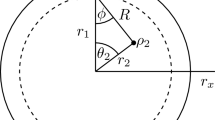Abstract
We consider the problem of maximizing the probability of transition from a given initial state to a given final state for an n-level quantum system using nonselective quantum measurements. We find an estimate from below for the maximum of the transition probability for any fixed number of measurements and find the measured observables on which this estimate is attained.
Similar content being viewed by others
References
M. S. Blok, C. Bonato, M. L. Markham, D. J. Twitchen, V. V. Dobrovitski, and R. Hanson, “Manipulating a qubit through the backaction of sequential partial measurements and real-time feedback, ” Nat. Phys. 10, 189–193 (2014).
M. Campisi, P. Talkner, and P. Hänggi, “Influence of measurements on the statistics of work performed on a quantum system, ” Phys. Rev. E 83 (4), 041114 (2011).
J. M. Dominy, G. A. Paz-Silva, A. T. Rezakhani, and D. A. Lidar, “Analysis of the quantum Zeno effect for quantum control and computation, ” J. Phys. A: Math. Theor. 46 (7), 075306 (2013).
S. Fu, G. Shi, A. Proutiere, and M. R. James, “Feedback policies for measurement-based quantum state manipulation, ” Phys. Rev. A 90 (6), 062328 (2014).
A. Hentschel and B. C. Sanders, “Machine learning for precise quantum measurement, ” Phys. Rev. Lett. 104 (6), 063603 (2010).
K. Kakuyanagi, T. Baba, Y. Matsuzaki, H. Nakano, S. Saito, and K. Semba, “Observation of quantum Zeno effect in a superconducting flux qubit, ” New J. Phys. 17 (6), 063035 (2015).
F. Lucas and K. Hornberger, “Incoherent control of the retinal isomerization in rhodopsin, ” Phys. Rev. Lett. 113 (5), 058301 (2014).
G. A. Paz-Silva, A. T. Rezakhani, J. M. Dominy, and D. A. Lidar, “Zeno effect for quantum computation and control, ” Phys. Rev. Lett. 108 (8), 080501 (2012).
A. N. Pechen and N. B. Il’in, “Coherent control of a qubit is trap-free, ” Tr. Mat. Inst. im. V.A. Steklova, Ross. Akad. Nauk 285, 244–252 (2014) [Proc. Steklov Inst. Math. 285, 233–240 (2014)].
A. N. Pechen and N. B. Il’in, “Existence of traps in the problem of maximizing quantum observable averages for a qubit at short times, ” Tr. Mat. Inst. im. V.A. Steklova, Ross. Akad. Nauk 289, 227–234 (2015) [Proc. Steklov Inst. Math. 289, 213–220 (2015)].
A. N. Pechen and N. B. Il’in, “On critical points of the objective functional for maximization of qubit observables, ” Usp. Mat. Nauk 70 (4), 211–212 (2015) [Russ. Math. Surv. 70, 782–784 (2015)].
A. Pechen, N. Il’in, F. Shuang, and H. Rabitz, “Quantum control by von Neumann measurements, ” Phys. Rev. A 74 (5), 052102 (2006).
A. Pechen and A. Trushechkin, “Measurement-assisted Landau–Zener transitions, ” Phys. Rev. A 91 (5), 052316 (2015).
M. K. Pedersen, J. J. W. H. Sørensen, M. C. Tichy, and J. F. Sherson, “Many-body state engineering using measurements and fixed unitary dynamics, ” New J. Phys. 16 (11), 113038 (2014).
F. Shuang, A. Pechen, T.-S. Ho, and H. Rabitz, “Observation-assisted optimal control of quantum dynamics, ” J. Chem. Phys. 126 (13), 134303 (2007).
F. Shuang, M. Zhou, A. Pechen, R. Wu, O. M. Shir, and H. Rabitz, “Control of quantum dynamics by optimized measurements, ” Phys. Rev. A 78 (6), 063422 (2008).
A. S. Trushechkin and I. V. Volovich, “Perturbative treatment of inter-site couplings in the local description of open quantum networks, ” Europhys. Lett. 113 (3), 30005 (2016).
H. W. Wiseman, “Quantum control: Squinting at quantum systems, ” Nature 470, 178–179 (2011).
Author information
Authors and Affiliations
Corresponding author
Additional information
Published in Russian in Trudy Matematicheskogo Instituta imeni V.A. Steklova, 2016, Vol. 294, pp. 248–255.
Rights and permissions
About this article
Cite this article
Pechen, A.N., Il’in, N.B. On the problem of maximizing the transition probability in an n-level quantum system using nonselective measurements. Proc. Steklov Inst. Math. 294, 233–240 (2016). https://doi.org/10.1134/S0081543816060158
Received:
Published:
Issue Date:
DOI: https://doi.org/10.1134/S0081543816060158



